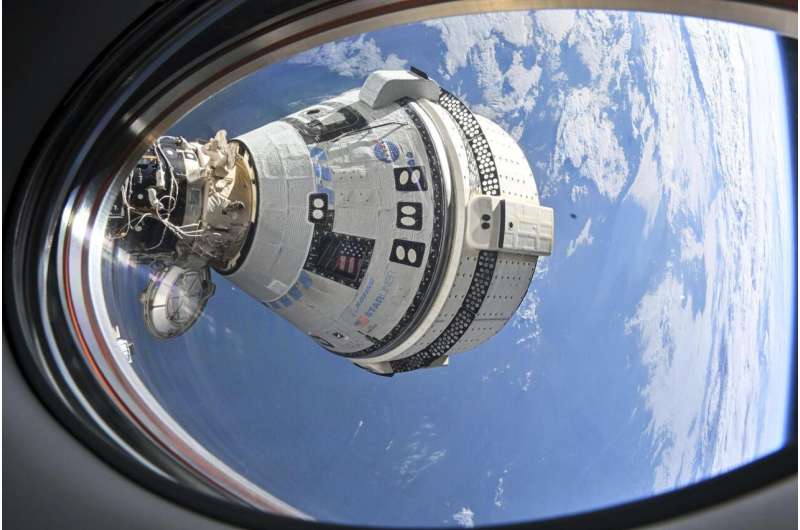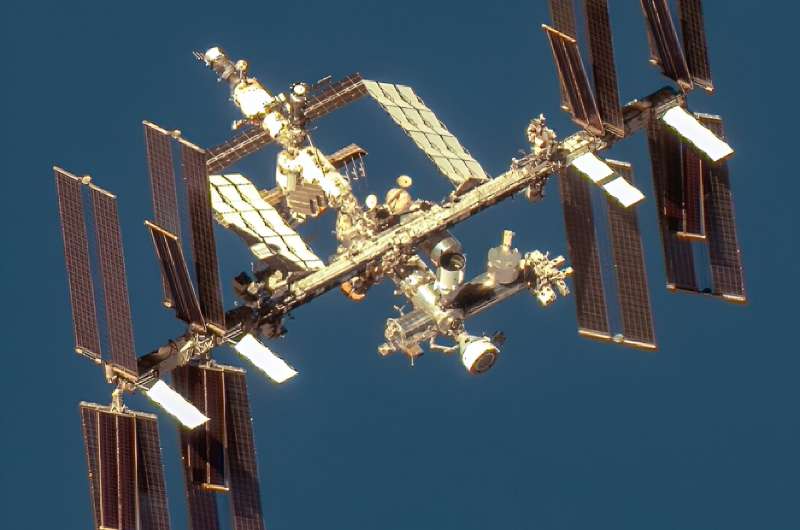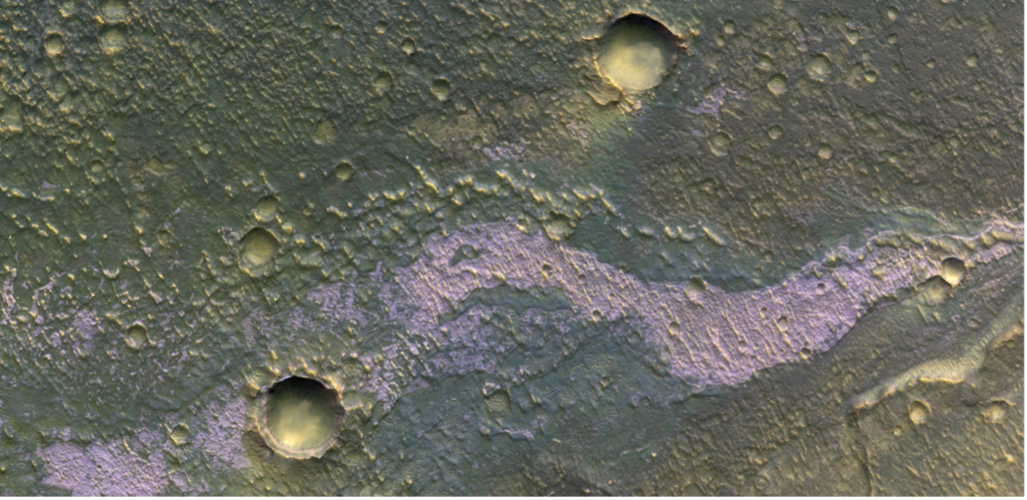Chinese megaconstellation launch creates field of space debris
Thursday, 08 August 2024 09:32

Gaia spots possible moons around hundreds of asteroids
Thursday, 08 August 2024 06:00
ESA’s star-surveying Gaia mission has again proven to be a formidable asteroid explorer, spotting potential moons around more than 350 asteroids not known to have a companion.
NASA says chances are growing that astronauts may switch from Boeing to a SpaceX ride back to Earth
Thursday, 08 August 2024 05:40
What should have been a quick trip to the International Space Station may turn into an eight-month stay for two NASA astronauts if they have to switch from Boeing to SpaceX for a ride home.
SpaceX delays Crew-9 astronaut launch amid uncertainty over Boeing Starliner
Wednesday, 07 August 2024 21:38 SpaceX has delayed this month's Crew-9 astronaut launch to Sept. 24, to accommodate a traffic jam at the International Space Station as Boeing's Starliner remains stalled at the orbiting laboratory.
SpaceX was scheduled to launch its ninth operational flight for NASA with four astronauts to the ISS on Aug. 18, before the space agency announced the delay Monday.
"This adjustment a
SpaceX has delayed this month's Crew-9 astronaut launch to Sept. 24, to accommodate a traffic jam at the International Space Station as Boeing's Starliner remains stalled at the orbiting laboratory.
SpaceX was scheduled to launch its ninth operational flight for NASA with four astronauts to the ISS on Aug. 18, before the space agency announced the delay Monday.
"This adjustment a Cygnus resupply spacecraft reaches ISS with four tons of supplies, experiments
Wednesday, 07 August 2024 21:38 Northrup Grumman's Cygnus resupply spacecraft reached the International Space Station early Tuesday morning, delivering some four tons of supplies to the orbiting laboratory, NASA said.
Cygnus completed installation on the ISS at 5:33 a.m. EDT, NASA said.
It brought 8,200 pounds of scientific investigation and cargo to the ISS's orbiting laboratory on the 21st resupply mission ca
Northrup Grumman's Cygnus resupply spacecraft reached the International Space Station early Tuesday morning, delivering some four tons of supplies to the orbiting laboratory, NASA said.
Cygnus completed installation on the ISS at 5:33 a.m. EDT, NASA said.
It brought 8,200 pounds of scientific investigation and cargo to the ISS's orbiting laboratory on the 21st resupply mission ca NASA delays SpaceX liftoff after Boeing Starliner stranding
Wednesday, 07 August 2024 21:38 NASA on Tuesday postponed the departure of astronauts bound for the International Space Station on a SpaceX flight due to ongoing issues with Boeing's Starliner spacecraft.
The Starliner, which brought two NASA astronauts aboard the ISS in early June, has been docked for the past two months due to anomalies detected in its propulsion system during its flight, with the mission's return date i
NASA on Tuesday postponed the departure of astronauts bound for the International Space Station on a SpaceX flight due to ongoing issues with Boeing's Starliner spacecraft.
The Starliner, which brought two NASA astronauts aboard the ISS in early June, has been docked for the past two months due to anomalies detected in its propulsion system during its flight, with the mission's return date i China launches first satellites for Internet megaconstellation into space
Wednesday, 07 August 2024 21:38 China on Tuesday successfully launched a satellite group up into space with more on the way aimed at improving broadband services across the massive Asian nation.
The group of 18 satellites were launched at 2:42 p.m. local time from the Taiyuan Satellite Launch Center in northern China's Shanxi Province attached to a Long March 6A rocket for Shanghai Spacecom Satellite Technology, which
China on Tuesday successfully launched a satellite group up into space with more on the way aimed at improving broadband services across the massive Asian nation.
The group of 18 satellites were launched at 2:42 p.m. local time from the Taiyuan Satellite Launch Center in northern China's Shanxi Province attached to a Long March 6A rocket for Shanghai Spacecom Satellite Technology, which Early Sea Level Changes Influenced Evolution of Ancient Life, Study Shows
Wednesday, 07 August 2024 21:38 A newly developed timeline of early animal fossils reveals a link between sea levels, changes in marine oxygen, and the appearance of the earliest ancestors of present-day animals.
The study reveals clues into the forces that drove the evolution of the earliest organisms, from which all major animal groups descended.
A team from the University of Edinburgh studied a compilation of ro
A newly developed timeline of early animal fossils reveals a link between sea levels, changes in marine oxygen, and the appearance of the earliest ancestors of present-day animals.
The study reveals clues into the forces that drove the evolution of the earliest organisms, from which all major animal groups descended.
A team from the University of Edinburgh studied a compilation of ro New Fossil Discovery Sheds Light on Mollusc Evolution
Wednesday, 07 August 2024 21:38 A team of researchers, including scientists from the University of Oxford, has uncovered a new species of mollusc dating back 500 million years. Named Shishania aculeata, this fossil reveals that the earliest molluscs were flat, shell-less slugs protected by spiny armor. These findings are published in the journal Science.
The discovery comes from well-preserved fossils found in eastern Yu
A team of researchers, including scientists from the University of Oxford, has uncovered a new species of mollusc dating back 500 million years. Named Shishania aculeata, this fossil reveals that the earliest molluscs were flat, shell-less slugs protected by spiny armor. These findings are published in the journal Science.
The discovery comes from well-preserved fossils found in eastern Yu Seawater barium removal enhanced marine habitability for Cambrian animals
Wednesday, 07 August 2024 21:38 This study, led by Dr. Wei Wei, PhD student Lin-Hui Dong, and Prof. Fang Huang at the University of Science and Technology of China, investigates the removal of excess barium and sulfide from seawater and its impact on marine habitability during the Cambrian Explosion.
Lin-Hui Dong analyzed excess barium contents (Baexcess) and isotope compositions (d138Baexcess) at the State Key Laborator
This study, led by Dr. Wei Wei, PhD student Lin-Hui Dong, and Prof. Fang Huang at the University of Science and Technology of China, investigates the removal of excess barium and sulfide from seawater and its impact on marine habitability during the Cambrian Explosion.
Lin-Hui Dong analyzed excess barium contents (Baexcess) and isotope compositions (d138Baexcess) at the State Key Laborator Detecting nitrogen dioxide emissions from power plants using Sentinel-2 satellites
Wednesday, 07 August 2024 21:38 Atmospheric nitrogen dioxide (NO2) is a hazardous pollutant with profound effects on air quality, climate, and the biosphere. While satellites have been mapping NO2 concentrations since the 1990s, their resolutions have generally been too coarse to identify individual sources such as power plants.
A recent study has made significant strides in air pollution monitoring by using imagery from
Atmospheric nitrogen dioxide (NO2) is a hazardous pollutant with profound effects on air quality, climate, and the biosphere. While satellites have been mapping NO2 concentrations since the 1990s, their resolutions have generally been too coarse to identify individual sources such as power plants.
A recent study has made significant strides in air pollution monitoring by using imagery from NASA considering returning Starliner astronauts on Crew Dragon
Wednesday, 07 August 2024 20:41

U.S. Army gears up for space warfare, drawing lessons from Ukraine
Wednesday, 07 August 2024 19:33

NASA weighs SpaceX rescue for stranded Boeing Starliner crew
Wednesday, 07 August 2024 18:57
What was meant to be a weeklong trip to the International Space Station (ISS) for the first NASA astronauts to fly with Boeing could extend to eight months, with the agency considering bringing them home on a SpaceX spaceship.
A final decision on whether to persist with Boeing's troubled Starliner—which experienced worrying propulsion issues as it flew up to the orbital platform in June—is expected later this month, officials said Wednesday in a call with reporters.
Detailed planning is already underway with Boeing's rival SpaceX, owned by Elon Musk, to potentially launch their scheduled Crew-9 mission on September 24 with just two astronauts rather than the usual four.


 Image:
Mermaid on salty Mars
Image:
Mermaid on salty Mars